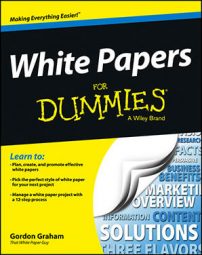Just about every white paper needs a few references to back up its arguments and showcase the research behind it. For the writer, keeping sources straight can be challenging. But not doing so defeats the point of finding them in the first place. And if the client is queried later and can’t produce any sources, it detracts from the company’s credibility.
The writer should bundle all the sources cited in the white paper and send them to the client. All white paper writers should follow this step for several good reasons:
To back up all their research for safekeeping
To enable the client to spot-check a few references and make sure the citations are letter-perfect before the white paper is published
To mark themselves as true professionals who do their homework and stand behind their work
Step Who What 10.1 Writer Assembles all sources as PDFs 10.2 Writer Keys file names of sources to footnotes 10.3 Writer Sends sources to client 10.4 Client Spot-checks sources (if required) 10.5 Client Files sources with white paper project files
What the writer does to check white paper sources
The writer gathers all the sources referenced in the white paper, keys them to the same numbers as the footnotes, and sends all the sources to the client. Throughout this step, the writer uses PDF as much as possible as the universal file format:
For a web page or blog post, the writer makes careful note of the precise URL and captures that web page as a PDF.
For a printed report or a book, the writer scans the pages to PDF.
For Word, Excel, or PowerPoint documents, the writer can either save those as PDFs or keep them in their native formats.
What the client does to check white paper sources
The client receives the bundle of sources from the writer. Then he can spot-check any references or quotes in the white paper as he wants and file away those PDFs with the rest of the project files for future reference.
Save white paper source material as PDFs
No client wants to get a hodge-podge of HTML, screen grabs, PDFs, and other file formats. That just complicates life. Instead, I recommend that the writer takes a few minutes to bring everything into one universal format.
If you’re the writer and you’re pulling white paper references from reports you found online, web pages, books, or printed documents, consider all these reasons for storing these sources as PDFs:
Some of your research is already in PDF format.
For web pages, you can print to a PDF, which saves the content even if that URL changes or that page is taken down.
For printed documents, you can scan to a PDF.
PDFs are easy to access with free readers from Adobe or third parties.
Key white paper sources to footnotes
Don’t send the client a set of PDFs with random file names. To make life easier for everyone, create a table to match each source to a footnote number in the final white paper. The simplest way is to use a number in the file name of each PDF that corresponds to the associated footnote.
If you’re the client, you can simply file away the bundle of sources with the rest of the white paper project files. But why not do a little quality control and spot-check a few references to make sure they’re letter-perfect? If you find any issues, check every source in the document.
Open the white paper and find the first footnote you want to check.
Open the PDF that starts with the same footnote number.
Search for the exact text or fact given in the white paper and confirm that it’s on the page given in the footnote.
Read both the source document and the reference to make sure they’re exact.
What if you can’t find anything in the source to match the reference in the white paper? What if it sort of matches but seems taken out of context or distorted?
It can be a simple mix-up on file names that you can straighten out yourself. Start at the first footnote in the white paper and run through your folder of source PDFs. The writer could have easily skipped over one and got all the file names out of order from that point on.
Find the spot for the missing source and check whether it’s anywhere else in your list with the wrong name. If not, ask the writer to provide you a new set of sources with the missing one and all the rest of the PDF file names numbered properly.
If it’s a matter of interpretation, use your common sense. Can you rewrite the sentence to create a more accurate reference and then run that by the writer as a comment? Give that a try.
In any case, you need to get back to the writer and have a frank discussion. Tell him what you found, and ask him to explain. You don’t want your white paper — and your company’s credibility — to rest on shoddy sourcing.
How to handle unused white paper sources
The writer may find some great sources that don’t end up in the white paper but are still relevant to the topic. If you’re the writer, don’t just delete those sources and waste all that research! Instead, e-mail them as a separate bundle to the client. Then if you do another white paper for the same client, you can pull on those sources for that project.
If you’re the client, check out those sources to see whether you can use them for a blog, slide deck, or any other marketing materials for your company.

